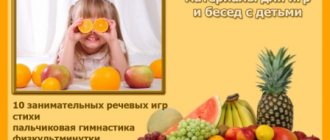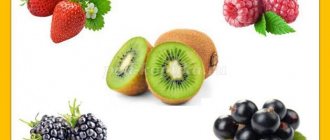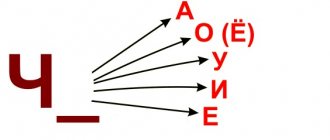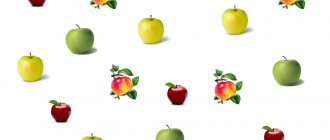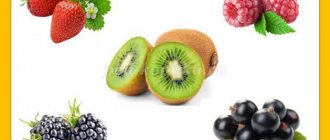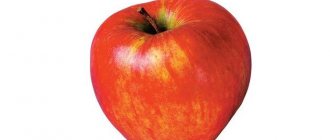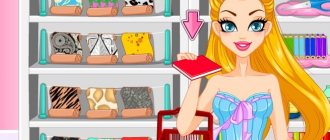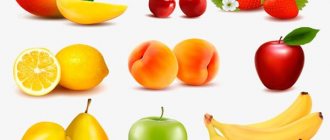Paintings on the theme “Fruit”
Ilya Efimovich Repin “Apples and Leaves”
We all know Ilya Efimovich Repin as a master of portraiture and a master of large canvases on mythological and historical themes (for example, the painting “Barge Haulers on the Volga,” which we discussed in the topic “Professions”). Still life was not the artist’s main genre, and we can say that the painting “Apples and Leaves” was created by accident. The still life, combining fruits and leaves, was created and staged by Repin for his student, young V.A. Serova. But the teacher liked the composition so much that he decided to paint such a still life himself.
A completely simple plot: six apples from the garden and a heap of leaves, but it’s all so native, Russian, realistic. The yellowish-green and red apples are not depicted as ideal “waxy” fruits, but as real, living fruits should look. It is felt that they have irregularities, dents and small spots. The simplicity of the painting makes the canvas a masterpiece worthy of the world's best halls and exhibitions.
Ilya Efimovich Repin loved nature very much. He lived 86 years and until his old age he slept in the cold, swam in the sea, never spent a day without gymnastics and ate a lot of vegetables and fruits. If Repin had a break from drawing, he found other activities for himself - riding a horse, swimming, working in the garden, planting plants or clearing snow in winter. And he did not hesitate to offer shovels to his guests, for example, Chukovsky, Mayakovsky or Chaliapin. Proper nutrition, physical activity, favorite work and the ability to live simply (without frills) are the main secrets of the longevity of the great artist. As in the painting “Apples and Leaves,” beauty is in simplicity.
Paul Cezanne "Still life with drapery, jug and fruit bowl"
Summary of a lesson on speech development in the middle group “Description of fruits”
Educational area
Speech development
The topic of the lesson is “Description of fruits.”
Implementation of program content in educational areas :
“Speech development”, “Artistic and aesthetic development”, “Cognitive development”, “Social and communicative development”.
Types of children's activities:
gaming, communicative, educational and research.
Goals:
learn to compare and describe fruits.
Program tasks
:
Educational: continue learning about fruits by solving riddles; learn to describe fruits by color, shape, size; learn to use adjectives in speech, forming them from nouns.
Developing: develop, knows how to maintain a conversation, expresses his point of view, logical thinking, attention.
Educational: To cultivate a caring and loving attitude towards nature, which has generously endowed us with its riches; develop the ability to listen to each other;
Vocabulary work:
fruit, fruity, orange, lemon, cherry, plum, peach,
Preliminary work:
looking at pictures of fruits, the game “What Grows Where”, a conversation on the topic “Fruits”, “Fruit preparations”.
Materials and equipment:
Hedgehog and Little Fox, envelope, pictures of fruits, ball, sheets of paper with images of ovals and circles; two pictures of fruits to find the differences, replicas of fruits, fresh fruits.
Contents of organized children's activities
1. Organizational moment.
Educator: Good afternoon! Happy hour!
I'm very glad to see you.
You turn to each other and smile.
And sit down quietly.
Educator: Guys, who came to us? (Hedgehog and Little Fox are sitting on chairs near the board, holding an envelope)
Children: Hedgehog and little fox
Educator: Yes, these are our friends. Guys, look, they are unusual today, Hedgehog has prepared something for us in an envelope. Let's open it and read it. (Takes the envelope and opens it)
Guys, our friends invite us to play and solve riddles.
Children: stand in a semicircle and look at the board.
2. Guessing riddles. Description of fruits by color and shape.
1.Round, ruddy
It grows on a branch
Adults love him
And little children (apple)
(hang a picture of an apple on the board and the children must talk about it).
Educator: What is this? What color is the apple? What shape? What size is an apple?
Children: The apple is red, round in shape. The apple is big.
2.With orange skin,
Looks like a ball
But the center is not empty,
And juicy and tasty. (Orange)
(There is a picture of an orange on the board).
Educator: What is this? What color is the orange? What shape? What size? Do you think an orange is sweet or sour?
Children: Orange, round in shape...
3.It's almost like an orange
Thick skinned, juicy,
There is only one drawback -
Very, very sour (lemon)
(there is a picture of a lemon on the board).
Educator: What is this? What color is lemon? What shape is it? What size is a lemon?
Children: answer questions
4.Blue uniform, white lining,
It's sweet in the middle. (Plum.)
(on the board there is a picture of a plum).
Educator: What is this? What color is plum? What shape? What size is the plum?
Children: answer questions
5. A whole herd of horses on one leash. (Grape.)
Educator: What is this? What color are grapes? What shape? What size are the grapes?
Children: answer questions
Educator: I’m sitting on a tree, round like a ball,
Red as blood, sweet as honey. (Cherry.)
Educator: What is this? What color are cherries? What shape? What size is the cherry?
Children: Cherry is red, round in shape. Small cherry.
Educator: Well done, guys. All the riddles were solved.
Educator: Guys, how can you call an apple, orange, lemon in one word? What is this? Children: fruit.
Educator: Guys, where do fruits grow?
Children: in the trees
Educator: What are the names of the trees on which fruits grow?
Children: fruit
Educator: Where do fruit trees grow?
Children: in the garden.
Educator: What is the name of a garden in which there are many fruit trees?
Children: orchard
Educator: Well done! The Hedgehog and the Little Fox are also happy with you.
Physical school
Educator: Let's rest a little. Leave the tables and come to me. Stand in a circle. And we will put the Hedgehog and the Little Fox in the center of the circle.
Children: Go out to the teacher’s carpet and stand in a circle.
“Yesterday we walked in the garden, They walk in a circle, holding hands.
We planted currants. They depict how they dig a hole and plant a bush in it.
We whitened the apple tree with lime and whitewash. Move your right hand up and down.
We fixed the fence. Simulates hitting with a hammer.
We started a conversation: They stand facing in a circle
- Tell me, our gardener,
What will you give us as a reward? One finger is bent for each name.
I will give you lilac plums and honey pears as a reward,
The largest ripe apples, They stretch their hands forward.
A whole kilogram of cherries
This is what I will give you as a reward.
A whole kilogram of cherries, that's what I'll give you as a reward.
3. Game “Which one? Which?".
Educator: And now we will sit down on the palace. The Hedgehog and the Little Fox will roll the ball for you and name the color and object in the singular,
for example, a yellow pear, but you have to say how it will be in the plural - yellow pears ..
Educator on behalf of the Hedgehog and the Little Fox: orange orange
Child: orange oranges
4. Coloring.
Teacher: gives each child a sheet of paper on which ovals and circles are depicted.
Children: according to the teacher’s instructions, paint the figures, then determine what the painted figure looks like.
Instructions: Color the shape in the first lower right corner green (apple)
;
in the upper left corner - yellow (lemon)
, in the middle - orange
(orange).
5. Game " Treats ".
Educator: Guys, but E. and L. don’t know why people grow so many fruits. After all, if you don’t eat them all at once, what will they do?
Children: they will spoil, they will not taste good
Educator: Let's tell our friends how to store fruit.
Children: boil, dry, freeze
Educator: What can you cook from fruits?
Children: jam, compote, juice, marmalade
Educator: I am the presenter, I give you a piece of fruit and ask: “What kind of orange juice?”
Child: orange
Educator: “What kind of peach juice?”
Child: peach
Educator: “What kind of apple juice?”
Child: apple
Educator: “What kind of pear juice?”, “What kind of banana juice?”, “What kind of lemon juice?” (you need to play with each child)).
6. Comparison of images.
Teacher: shows a picture on the board
Children compare two pictures, find and name the differences.
7. Game “Forgetful buyer”.
A “seller” and a “buyer” are selected. Models or pictures of fruits are laid out on the table. The “buyer” says that he forgot the name of the item he wants to buy. The “seller” asks to describe the item: color, shape, taste, what it feels like, what it’s like inside. Based on the description, the “seller” guesses the fruit that the “buyer” wants to buy.
8. Reflection. Game "Define the taste."
Educator: Hedgehog and Little Fox brought us treats. Now you and I will put blindfolds on our eyes, go up to the table and taste what kind of fruit it is? Well, the Hedgehog and the Little Fox will see if you complete the task correctly or not. Children: close their eyes and take the prepared fruits into their mouths and guess what they ate.
Educator: Well done! It's time for the Hedgehog and the Little Fox to return to the forest, let's say goodbye to them. Goodbye, guys..
Children: Goodbye
Music on the theme "Fruit"
Karen Khachaturyan "Cipollino - Prince Lemon"
The middle of the 20th century can be called, without exaggeration, the “golden age” of Russian animation. The artists carefully worked out every stroke, the cartoons were voiced by first-class actors, and great attention was paid to music. The music was bright, memorable, imaginative, capable of capturing a child’s imagination.
For example, remember the wonderful cartoon “Chippolino”, created at the Soyuzmultfilm studio by director B.P. Dezhkin in 1961. I still remember the bright musical compositions that sounded in the cartoon. The music for this cartoon was written by the great Soviet composer Karen Khachaturyan. 13 years later, based on this music, Karen Khachaturian created a children's ballet of the same name.
According to the composer, Gianni Rodari’s fairy tale captivated him so much that its characters lived in his imagination for a long time. “I couldn’t forget the cheerful Cipollino, the gentle Radish, the noble Cherry, the evil, loud Lemon... And for some reason, each hero now appeared to me in a dance,” admitted Karen Surenovich. Thus was born the idea of a ballet, which was embodied in a complete work in 1974. The choreography for the ballet was composed by choreographer Genrikh Mayorov.
The fate of the ballet was brilliant from the very beginning. The composer became famous throughout the world, and the ballet itself became one of the best in contemporary art aimed at children. The main roles in the ballet were performed by such famous dancers as Maris Liepa, Nikolai Tsiskaridze, Nina Sorokina, Marina Kondratieva and many others.
Some information about Karen Khachaturyan. He was born in Moscow into the family of a theater director. In 1949, Karen graduated from the Moscow Conservatory. His teachers and mentors included Dmitri Shostakovich, Sergei Prokofiev and Igor Stravinsky. Shostakovich emphasized Karen Khachaturian’s “depth of thought, masterly development of material, perfection of its implementation, beautifully flowing melodies, amazing sounds.” Karen Khachaturian composed music for symphony and small orchestras, for violin, cello and piano. Wrote five symphonies. Since 1950, Karen Khachaturian has written music for films and cartoons. The most famous of them were: music for “Cipollino” and for the film “Viy” with Natalya Varleya. In 1981 he was awarded the title of People's Artist of the RSFSR.
We invite you to watch the wonderful cartoon “Chippolino” with your children. And discuss many of the topics raised in the cartoon: mutual assistance, courage, inequality. Well, and, of course, find heroes who belong to vegetables. And the music, of course, listen more carefully to the music written by Karen Khachaturyan.
APPLE
The amber apples are ripe on the apple tree. Yana and Yasha ate amber apples. (N. Lunina) Everyone knows what an apple looks like. This is not surprising. An apple is among fruits as a potato is among vegetables. Apple orchards on our planet occupy five million hectares. This is the most common fruit tree. The apple has been known to people since ancient times. There is a mention of this fruit in the Bible. It was the apple that Eve plucked from the tree of the knowledge of good and evil. Ancient Greece is considered the birthplace of the home apple tree. The ancient Greeks and Romans considered the apple a symbol of love and dedicated it to the goddess of beauty. The ancient Germans were sure that apples were the favorite fruit of the gods. They planted apple trees around their houses, hoping that the evil storm god would not throw lightning arrows at them. In Russia, apple trees began to be grown already in the 11th century. In 1051, an apple orchard was founded in the Kiev Pechersk Lavra. The first apple orchards appeared in the Moscow region in the 12th century. by order of Yuri Dolgoruky.
On August 19, Rus' celebrated the Apple Savior. Until this time, apples were not supposed to be picked. On this day, ripe fruits were collected from apple trees and blessed in churches. Apples were given to the poor and homeless. The more beggars you treat, the more abundant the harvest will be next year. Housewives baked apple pie on this day. Several hundred varieties of apples are known in Russia. They are divided into summer, autumn and winter. In the second half of September, winter varieties of apples were collected: Antonovka and Semerinka. The skin of these varieties is thick, with a special waxy coating that protects the fruit from rotting. You can store them until spring. Apples are eaten fresh, dried, soaked and frozen. They are used to prepare juices, compote, jam, jam, marmalade, and jelly. Apples are very useful. It is no coincidence that the Russian people created a fairy tale about rejuvenating apples. Eat them and you will be young and healthy. Apples contain vitamins, sugars, iron, potassium and magnesium salts. RIDDLE Same with a fist, Red barrel. If you touch it with your finger, it’s smooth, And if you bite it, it’s sweet. (Apple) PROVERBS AND SAYINGS • September smells like apple, October smells like cabbage. • No apple falls past the apple tree. • Like the tree, so are the apples.
QUINCE
Transcaucasia and Central Asia are considered the homeland of quince; it is in these areas that it is now found in the wild. Quinces have been grown since time immemorial, more than 4,000 years ago. The Latin name for quince is Cytfonia, presumably derived from the city of Cydon on the island of Crete; it was widely cultivated already in the first millennium BC. The ancient Greeks treated the quince with respect; for them it was a symbol of beauty and fertility. It was customary to treat newlyweds to quince. According to one version, the cause of the discord between Hera, Athena and Aphrodite was not an apple, but a quince. Currently, about 400 varieties of quince are known. They differ from each other in the structure of flowers and the shape of fruits. True, the differences between them are not as significant as, for example, between apple varieties.
Quince fruits are yellow in color with different shades, sometimes with a slight blush, very dense, hard and crunchy. If there are greenish spots on the quince, it means that it is not yet fully ripe. The pulp of this fruit is slightly viscous, tart and quite aromatic - the smell has something of an apple, and there is also a coniferous tint. You should only eat ripe quince; it is advisable to give it a chance to age. The longer it sits, the tastier, more aromatic and softer it becomes, the astringent taste disappears. Quince is a very healthy fruit. It contains potassium, magnesium, calcium, vitamin C, malic and citric acids. Quince pulp is rich in pectin. Quince is a universal fruit. It is eaten raw, it makes delicious compotes, jams, preserves, candied fruits, it can be added to porridge, salad, vegetable soup. Quince mustard is a seasoning made from quince and mustard with the addition of ginger and coriander. Quince cheese is condensed quince juice with pulp. Quince is grown in many countries of the world - in Europe, North America, North Africa, East and Central Asia. Cold-resistant varieties have also been developed and are successfully cultivated in the Volga region. Another variety of quince is Japanese quince, or chaenomeles. The flowers and fruits of this plant are similar to quince. Chaenomeles was brought to Europe from Japan at the end of the 17th century. Gradually it gained popularity among gardeners - it has very beautiful decorative flowers. Japanese quince fruits are also edible, but they are more sour.
- To the begining
- Back
- 1
- Forward
- In the end
